Investing in a residential home battery and solar system is generally considered feasible only if the payback falls within the battery warranty period – typically 10 years. According to this bloke, that’s easily doable.
Josh Mylne is, among other things, a dad, a scientist, and an energy nerd. He has an unhealthy addiction to Excel spreadsheets, only perhaps surpassed by SQ’s Ronald Brakels.
He’s extracted an obscene amount of data from his various apps and home energy bills and reckons his solar power, battery, heat-pump and induction cooking set-up is on its way to paying for itself in less than 10 years. Way less.
Josh lives in my home state of WA, so I thought I’d go around and have a chat – or as his wife calls it, “nerd out together”.
Unhealthy Addiction
The Excel addiction and energy nerdism started around 2005 when Josh and his family moved from the UK back to Australia. They were skint, so due to budgetary constraints, out came the Excel spreadsheet to guide their finances.
They continued being a one-car family and used bicycles as much as practical. Fast forward to the COVID-19 pandemic and the decarbonisation journey began in earnest.
On Go The Solar Panels
In November 2020, they had rooftop solar power installed. The system consisted of 19 x Q.MAXX-G2 Qcells 350W solar panels (6.65kW total), and a Huawei SUN2000 single phase 5kw hybrid inverter.
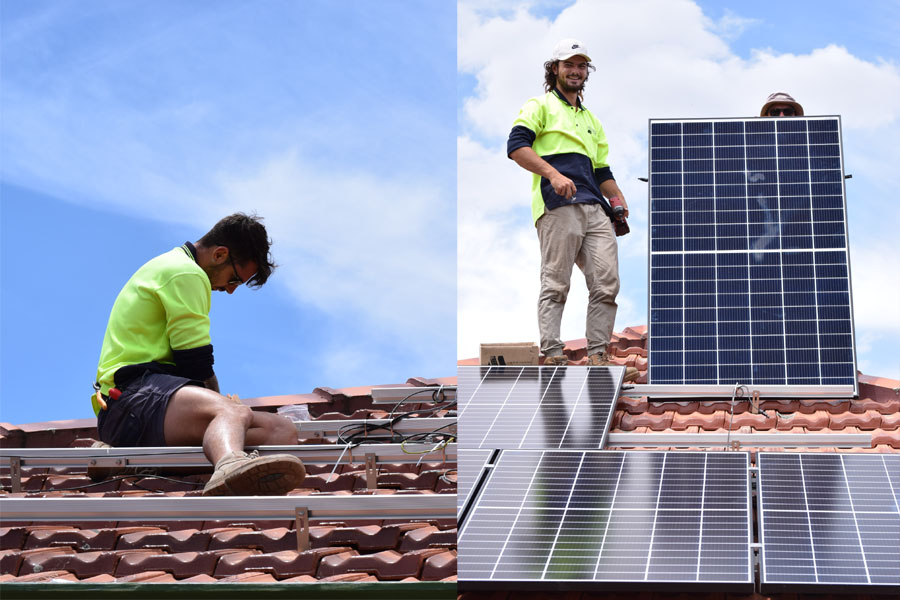
Installing Josh’s initial Q.MAXX-G2 Qcells 350W solar panels. Image: Josh Mylne
Josh says: “I knew nothing about solar at the time. This video on YouTube from the Solar 101 webpage is 25 minutes and it explains everything. After watching it, I used the SolarQuotes website to arrange three quotes and the guide at Solar 101 to work out what was quality gear.”1
After the solar panels were installed, the electricity bills dropped by about $950 p.a. But that wasn’t enough for Josh. He’s not a big fan of supply charges or the miserly feed-in tariff offered by Synergy in WA. He became a net exporter of electricity, but that didn’t reflect in power bills due to the difference in import tariff (30c per kWh) and feed-in tariff (2.5c to 10c per kWh), and the aforementioned supply charge ($1.07/day). Grrr. More work to do.
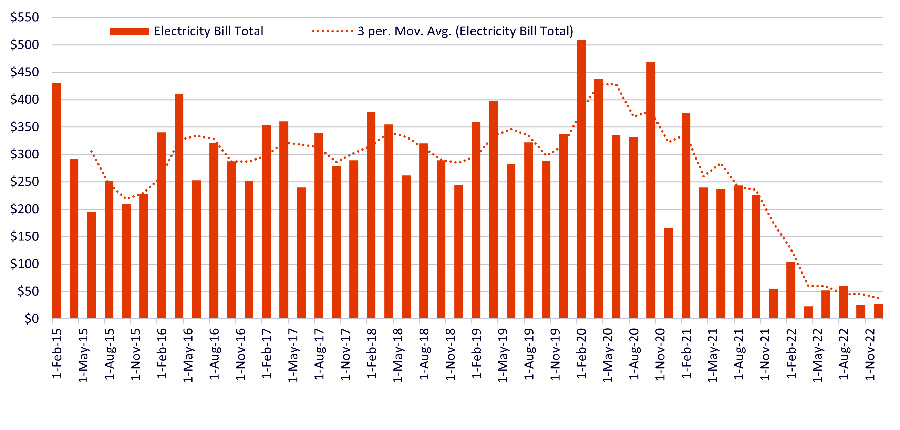
Josh’s electricity bills from February 2015 to November 2022. See the big dip in November 2020 when the solar panels went on, then again in November 2021 with the battery + additional solar. Image: Josh Mylne
See Josh’s electricity usage graph below compared to the bills above. He became a net exporter in November 2020 but it didn’t reflect in his electricity bills. Not happy Jan.
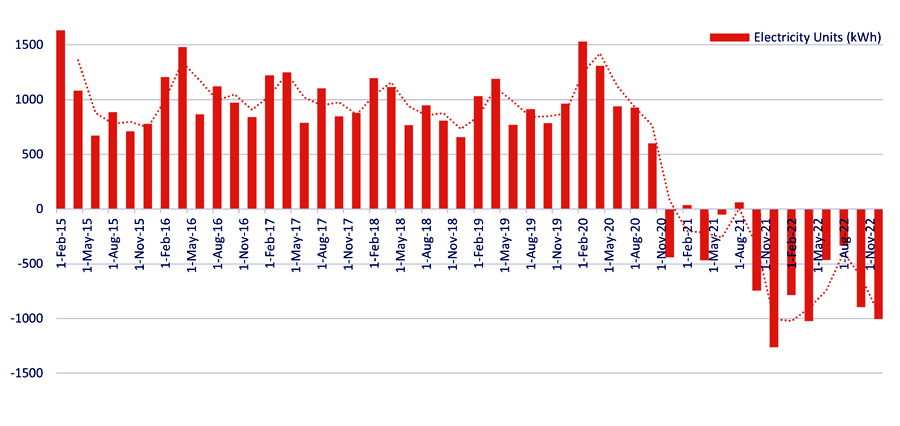
Josh’s electricity usage from February 2015 to November 2022, showing his net exports after the solar power system installation. Image: Josh Mylne
Getting Off The Gas
The goal was to decarbonise their lives as much as possible, so getting off the gas was a priority. At the same time as the solar panels went on, the gas hot water system was replaced with an iStore 270L heat pump.
Gas usage immediately plummeted by 95%. The bill, however, dropped by only about 80% – still an impressive saving of $750 p.a. This was once again because of the despised supply charge. A kitchen renovation in July 2022 provided an excuse to ditch gas altogether when they installed an induction cooktop, providing further savings.
Having no gas bill now saves them $900 p.a. The only gas at their place now comes out of a bottle when they fire up the BBQ.
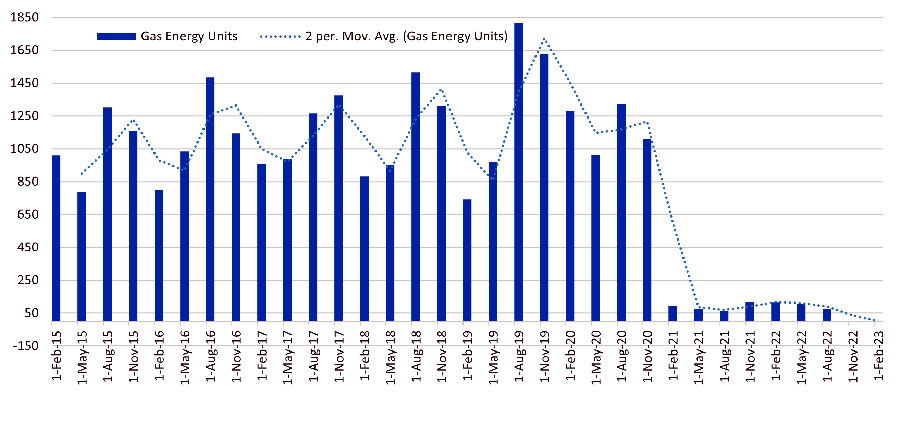
Josh’s gas usage chart below shows a huge drop in November 2020 with the new heat pump, which disappears in August 2022 when the gas was cut-off. Image: Josh Mylne
What’s The Heat Pump All About?
I’ll let Josh tell you:
“The heat pump is brilliant. It works like an inside-out fridge; the cool air being dissipated and the heat being released into coils heating the water. It has various modes, but we have ours set to come on at 11 am and not to cycle after 5 pm, which means it’s usually using solar energy to heat the water.”
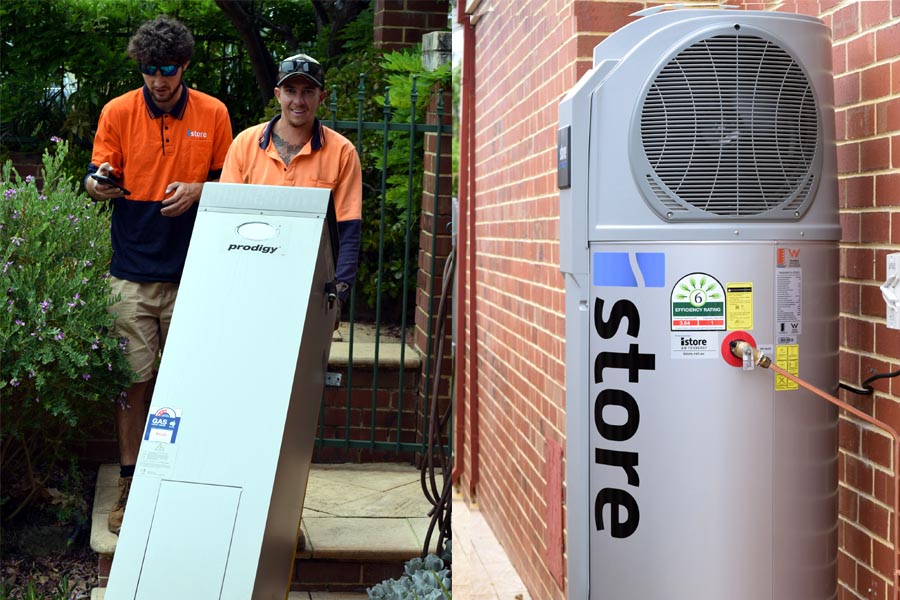
Out with the old gas boiler and in with the new iStore 270L heat pump. Image: Josh Mylne
“We’ve not run out of hot water yet, despite having three teenage boys. By using solar energy and then storing the energy in the water as heat, in ways it’s acting like a battery. It only draws about 1.2 to 1.6kW while it’s running. It runs usually for about 90 minutes each day and works better the warmer the air around it is.”
Home Battery + More Solar Power
Not content with the savings already achieved, the family decided (or maybe Josh decided) to purchase a home battery in November 2021. At the same time the Huawei Luna 10 kWh battery2 was installed, they threw another 7 x 350W solar panels on the roof, bringing it to a total of 9.1kW of solar capacity.
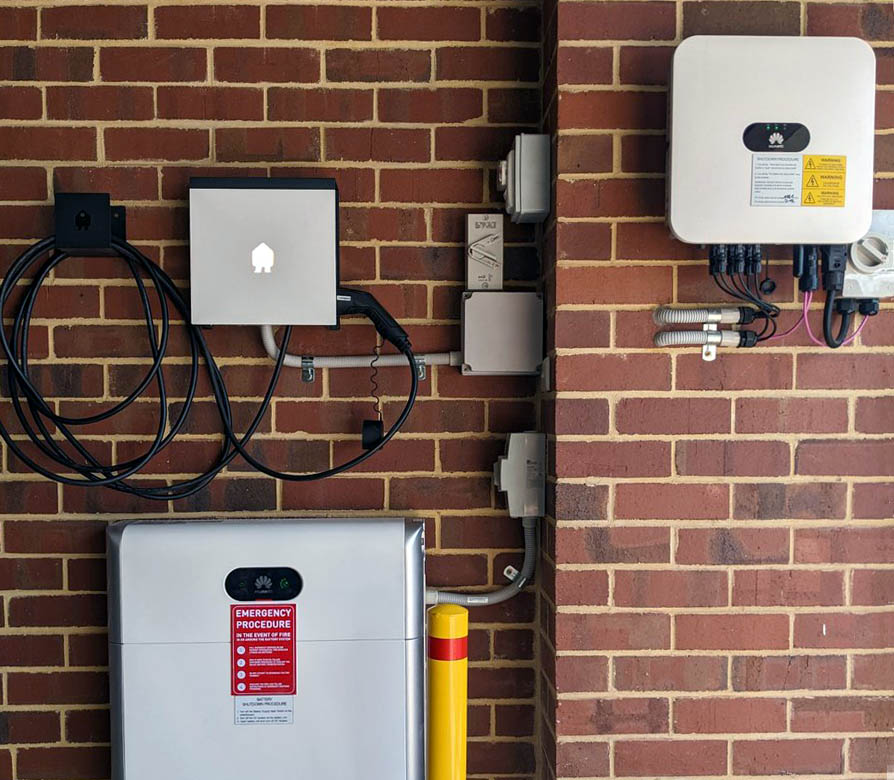
Happy family: Huawei SUN2000 single phase 5kw hybrid inverter, Huawei Luna 10 kWh battery, and Smappee EV Wall Charger. Image: Josh Mylne
Josh must have been bouncing off the walls in excitement at the thought of expanding his Excel spreadsheet to include the battery. He’s now worked out they’ve become 93% self-sufficient for energy. To put it another way, only 7% of the electricity they use comes from the grid, averaged over the whole year.
He says that the battery gets them all the way through the night 310 days per year (84.9%), although it’s almost impossible to have a day that’s 100% self-sufficient as any spike of use that goes above 5kW has to be covered by the grid.
“After one full year with the battery, I analyzed how often the battery gets you all through the night to the next day (see the graph below). Out of the whole year, 341 days (93.4%) made it past 9 pm, 334 days (91.5%) made it past midnight, 320 days (87.7%) it got past 4 am, and 310 days (84.9%) it made at all the way through all night to the next day with no grid draw at all.”
I must admit at first glance I struggled to ‘get’ the graph below, which shows the ability of Josh’s battery to see them through the night without grid power, over a period of 12 months. The green is not actually a Christmas tree, but the data. The white bars (which look like the data) are, in fact, showing where the battery didn’t make the distance, and the grid kicks in. If you stare at it long enough it’ll make sense.
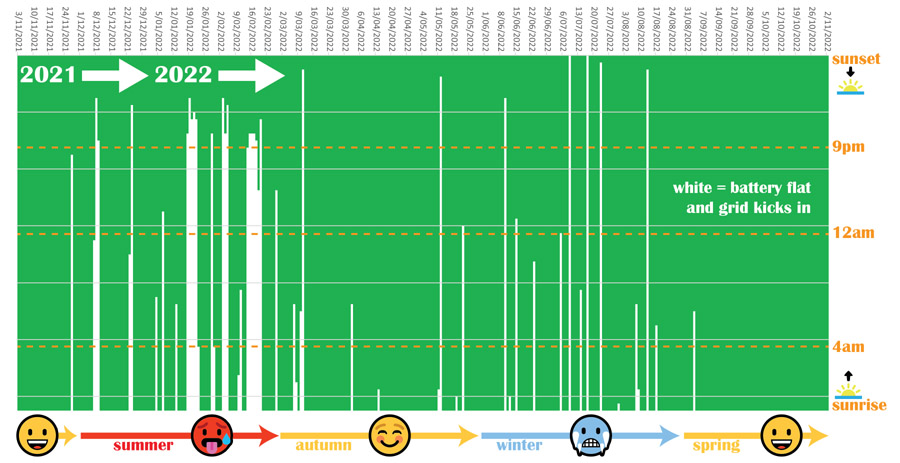
Josh’s ‘Battery Through The Night’ graph. Image: Josh Mylne
You can see the heatwaves in late summer where a few days in a row the battery was drained by 9 pm thanks to the air conditioner. Winter had the occasional super overcast/ rainy day when the battery didn’t fully charge, as you almost always see single white bars.
Hot tip for WA solar buyers:
Josh’s solar, battery and inverter are DC-coupled, giving him potentially more power to charge the battery than an AC coupled system would. As the battery is connected to the DC side of the hybrid inverter, its input is not limited by the 5 kW nominal inverter rating, and so can take advantage of all the unclipped power available from the solar array to charge the battery.
This works particularly well in systems where the DNSP rules limit single-phase inverter sizes to 5 kW (WA), and a bonus in battery systems where panel capacity is more than 133% of the inverter rating. Josh’s system ticks all the above boxes – Western Power inverter limit: 5 kW (single phase), Josh’s solar: 9.1 kW, Josh’s inverter: 5 kW. This could arguably be a significant factor in trimming down the payback time for a home battery.
Out With The Diesel And In With The EV
In September 2022, the family became proud owners of a brand new BYD Atto 3 electric vehicle. I’m jealous as hell. This EV has (sort of) replaced their aging 2011 diesel Holden Captiva which had clocked over 230,000km. They’re hanging on to the Captiva for now, as the two oldest sons are now driving age.
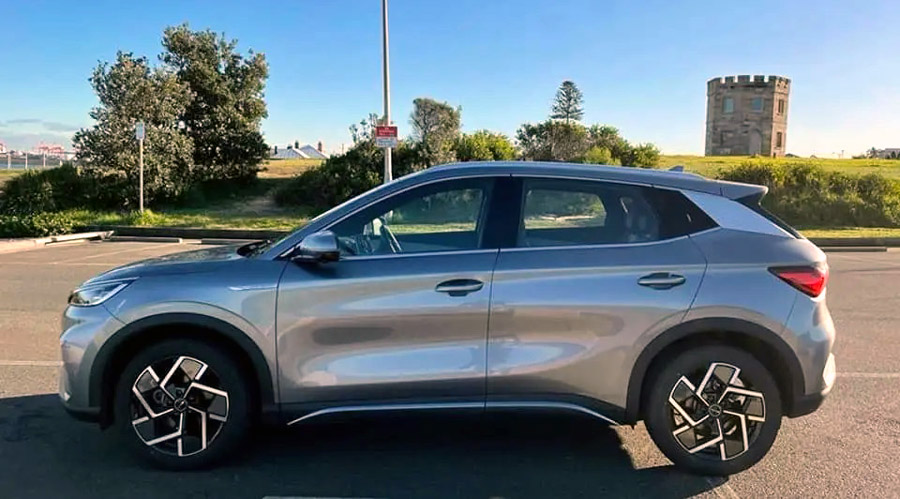
BYD Atto 3 electric vehicle. Image: The Driven
Prior to the kids growing up, the fuel bill was $3,000 p.a. Yes, there’s a spreadsheet for that too (graph below). Fuel costs then spiked to $4,500 p.a. with the new drivers, and then since the EV purchase has dropped down to $30/ quarter so far.
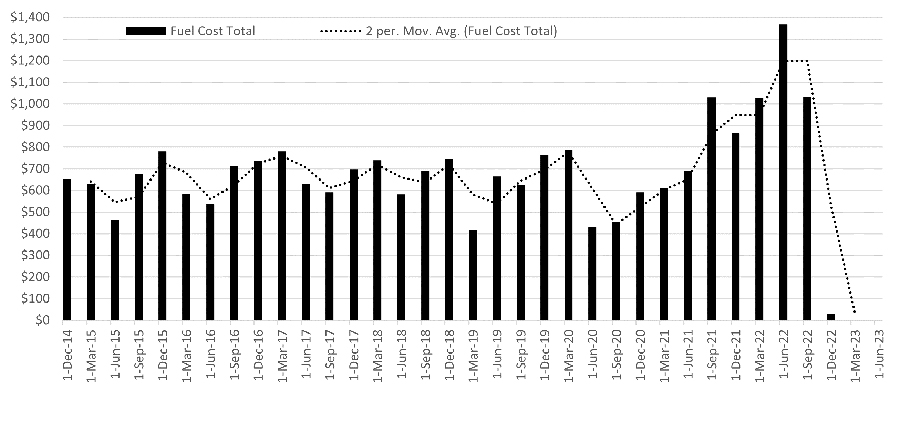
Josh’s fuel costs since December 2014. We’ll see how that pans out since the arrival of his fancy new EV in September 2022. Looking good so far. Image: Josh Mylne
Josh says the Atto 3 is a nice car to drive, with a range of 480km on a full tank charge.
“The EV gets driven about 250 km a week. I commute by bike, but my wife leaves for work before the solar kicks in and gets home after sunset, so we charge the EV on weekends. Sometimes during the week, if I’m working from home, I’ll drop my wife at work and leave the EV at home charging. We have a Smappee EV Wall Charger that has a smart mode that uses only surplus solar to charge the car.”
The Bottom Line
So pretty pictures and graphs aside, after extracting data from Josh’s spreadsheets, he reckons the combined solar power plus battery investment will pay back in 6.4 years. This is a conservative estimate because the cost of the heat pump and induction cooktop could arguably be left out of the equation as the gas appliances were at the end of their life. That would bring the payback down to 4.9 years.
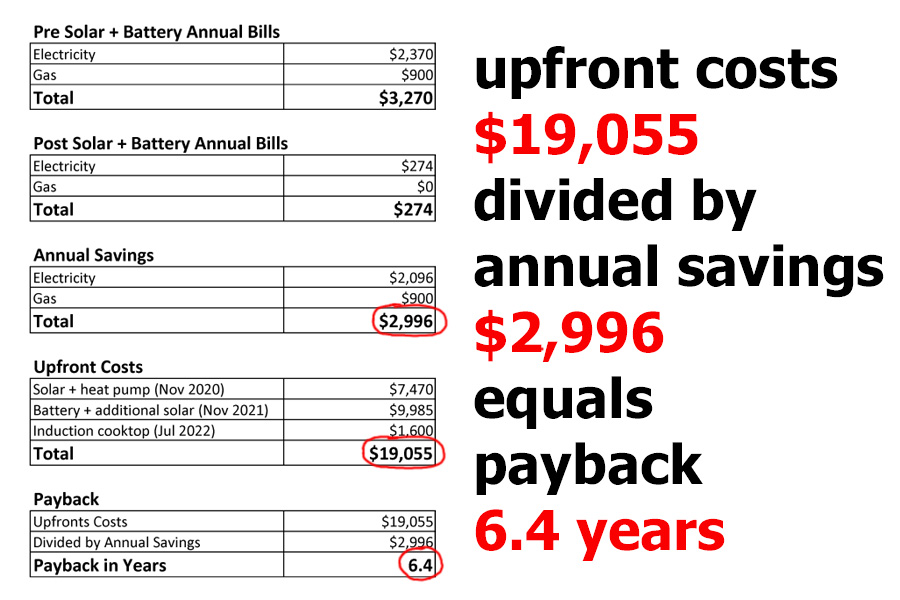
The bottom line – Josh’s combined solar + battery payback estimate. Image: SolarQuotes
The EV is not included because he only has about three months of data. I’m sure that in about nine months we’ll see a new Excel spreadsheet with a full-blown fuel savings analysis, including the full cost of ownership and depreciation comparison between his EV and the old Holden Captiva.
There’s one more thing Josh would like to say about that.
“The whole payback equation changes if you can power your car with surplus solar, which we do. A tank of diesel costs $110 and gets us 400 km. With the EV, a 60 kWh full charge gets us 480 km, and costs literally 2 or 3 dollars. That’s all I get if I feed 60 kWh into the grid.”
Like many solar power system owners and people in the industry, Josh didn’t start his decarbonisation mission to save money. That’s just an added bonus.
“I went solar not just to save money, but to make less carbon dioxide myself as well as, in a tiny way, help hasten the decline of wasteful, polluting, and increasingly expensive fossil fuels.”
Thanks for doing some of the heavy lifting, Josh. I’m 100% with you on that. You can follow the rest of Josh’s journey as it evolves on his own blog right here.
Footnotes
- That sounds like a shameless plug for SolarQuotes doesn’t it, but these are Josh’s volunteered words. ↩
- This is worth a read: The Huawei Luna2000 Battery Review: Tantalisingly Close To Paying For Itself ↩

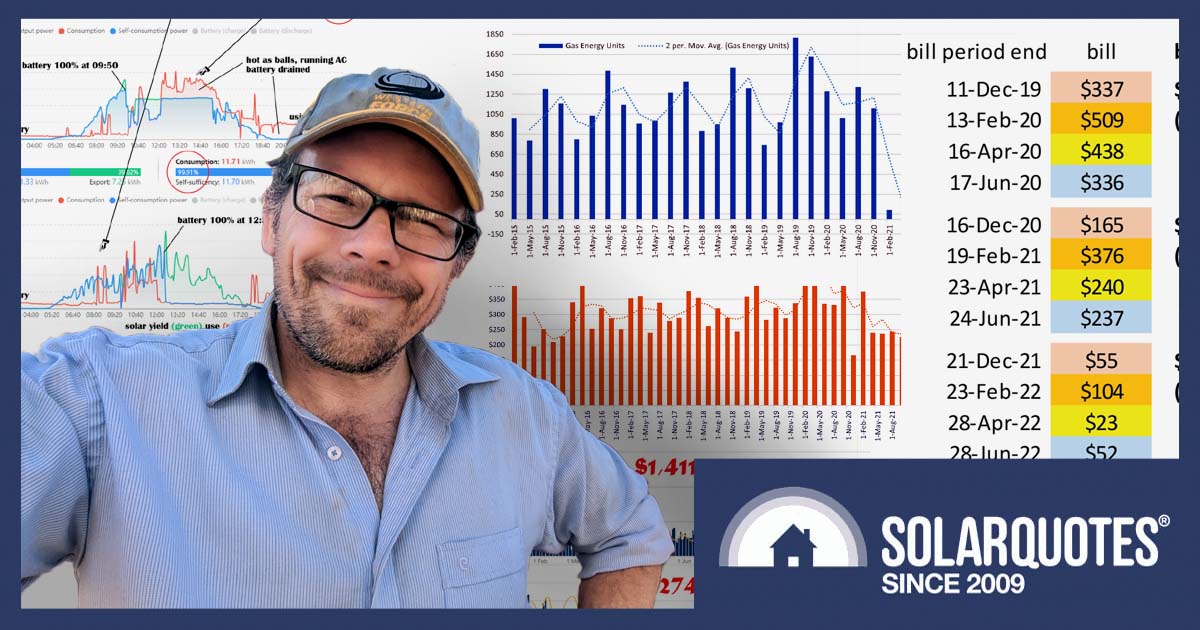
 RSS - Posts
RSS - Posts



I had a 11.78 kW system installed at the end of last year, with a Powerwall2 included (at the previous price point of around $16,000, not the new $20K price). Based on my calculations at home, and we’re a 5-person family, both panels and battery will pay for themselves inside the 10-year warranty even without shifting to full electric motoring (we have hybrids). Annual electricity bills previously were about $3000. System (including battery) cost about $30K, so 10 years is about the payoff point. The panels alone would have paid for themselves in under 5.
That partly reflects the higher energy usage of a large household being offset. All heating/cooling was shifted to electric years ago, and it’s cold where we are so heating is a large cost. The only non-electric energy use in the house now is hot water, which is a Rinnai Infinity 26, which is efficient. I have toyed with a heat pump hot water system, but they have some reliability issues in my experience. I’m actually curious if the credits I earn from the solar may also be enough to pay the gas bill.
I also continue to question the logic that says a battery is only worth it if it pays for itself. Using that logic nobody would ever buy a car either, we’d all use taxis and rideshare instead, it’d be much cheaper. Double standards often apply in energy debates.
Nick, your car logic is flawed. Based on current taxi fare data I looked up, a basic petrol car purchase will pay for itself in under 10 years, potentially under 5. Okay it depends on your situation but the more regularly you visit the shops, and do other activities, the faster it pays for itself. And if you use it for work …
An EV may have better repayment potential – no need to pay for petrol, and if you can charge off home solar it’s completely free, but they’re also something like twice the price of an ICEV, have higher insurance, and some mechanics are saying they’ll be more expensive to care for than ICEVs.
There’s actually an interesting piece here: https://www.news.com.au/technology/motoring/the-chart-that-explains-why-electric-cars-may-never-pay-for-themselves/news-story/41ac37b434bff36bcc90760c5ed851fc
Based on the data above an ICEV is the optimal option for my situation. It’s also probably more environmentally friendly. 🙂
Hi George. With capital costs of buying the car, plus maintenance, fuel and depreciation, I can’t see how somebody can ever get close to it being a cheaper option than using taxis, rideshares and public transport. I live in a regional area, as an example. My daily commute is 120km. With a standard fossil fuel vehicle, it’s at least 60 litres of fuel per week. At current prices that’s $100-$120, and doesn’t factor in wear and tear on the car and depreciation. If I take the local bus or train though (which i did for years), the trips cost me about $50 per week, with no capital costs or depreciation. Less than half the cost of owning a car.
Similarly if all of my trips were around town during the week, even if i did two reasonably long trips per day and spent $20-$30 in taxi fares, so $100-$150 per week, that’s almost a decade of trips before I get close to what it would cost to buy even a mid-sized vehicle. And that vehicle would have fuel costs and maintenance and depreciation.
I think cars are money sinks. Much as I love them. We don’t own them to save money.
Nick, thanks for the reply. Compared to walking, any car – EV or ICEV, is an expensive option. But walking isn’t an option plenty of places so some form of transport is necessary.
Have you looked to see what a taxis to your local supermarket would cost? What would it cost to get to your local doctor, your bank, or any other regular essential service? And while yes you could perhaps catch a bus or train to a supermarket, you can’t carry a bootload of groceries home sans car.
I think we’re talking different scales though. You say if you did 2x long trips per day and spent $20-$30 total, except those aren’t long trips, they’re ultra short hops. Based on the estimator I used that’s about 2x 5 minute\10 km trips, easily walking distance for someone in decent shape, if a little time consuming – or I guess you could ride. If you’re spending an hour travelling to get to a shopping centre then your tax fare will be proportionally greater.
As for almost a decade of trips to get even a mid-sized car, perhaps we’re considering different scales again? Taking the mid-point of your figures ($125) and you have enough for 2x mid sized cars in a decade – but perhaps you don’t consider a Corolla a mid-size car?
Cars may be money sinks – capital, fuel, maintenance, insurance, rego etc, but there are worse options, like having to pay for taxis all the time.
To me it’s like the argument that rent is ‘dead money’, you’re better off with a mortgage. Interest to a bank is even more dead than rent. It’s nearly always been cheaper to rent than to own a home in Australia, until recently anyway. I remember Phil Ruthven doing the sums a few years ago and calculating that most people would be lucky to get 4% return on any house, by the time all the costs (including mortgage interest) are factored in properly. Banks wouldn’t make a fortune from home lending if that wasn’t true.
With cars a lot comes down to how many trips and km a person does per week. And where they do those kms, like regional vs city (which will tend to include parking costs as well, in many situations). My point is a home battery makes at least as much if not likely more economic sense than owning a car, if people just want to look at dollars and cents.
How were you able to install an 11.78kW system plus a Powerwall2 – that would make the total inverter capacity 16.78kW which is above the 10kW permitted? Are you on 3 Phase?
Single phase.
11.78kW of panels, think the total micro-inverter capacity (panels) is about 10.8kw. They ‘overclocked’ the inverters, well within the allowed one-third limit.
I think the Powerwall inverter is to convert stored energy to AC for the house? Not to the grid. But others would know more about that than me.
Cheers
That’s great Josh, it gives us all hope that a cleaner energy household that saves us money and heralds the possibility of slowing climate change is indeed possible.
Josh,
have a look at Home Assistant: It is a home management system that might save you some work on the spreadsheets! It runs on a little computer, like a Raspberry Pi, or similar. Incredibly powerful & Open Source.
Interesting article! The addition of more than 6.6kW in panels in WA means the installation of a “Smart Meter” is mandated to avoid more than 5kW of feed-in/phase and that smart meter costs an extra $500 and I hope that figure is in the spreadsheets!
A worry is the previous article in Solarquotes re batteries tested in Canberra’s institute, where only one battery out of 26 made the grade and one hopes that one is it!
Josh sounds like a man after my own heart
I too have cycle commuted most of my life and am a spreadsheet and other data addict. I have a weekly spreadsheet going back to 2009 but never thought to record ‘bills’ as we haven’t had one since then
I also share Josh’s hatred of unavoidable supply charges
We bought a Wattson whole house meter years ago and got free Emberpulse and Emberair meters. Data is key. It is a sickness.
My quick calc tells me our new plug and play off grid batteries (6.4kWh) and dirt cheap second hand panels will pay for themselves, just, in 10 years. Much sooner if we get an EV as we are spilling in Summer after midday on most days.
Josh:
You have put together a great system solution, and the proof is in the pudding [Excel Spreadsheets in this case] and well done mate.
From your “Battery through the night Graph” I see that there are high demand periods [the grouped white lines] that are the major contributor to an overdemand situation on the Battery; which occurs during the day [air conditioning] which has a knock on effect during the night due to the diminished battery SOC caused almost exclusively by the AC circuit.
There is an elegant and cost effective system design improvement that might work for you, and the fix has an additional knock on benefit for your EV charging situation moving forward, which you haven’t included in the graph but you will need to include that in the future stats.
The fix:
Take the Air Conditioning Load circuit off the Battery Supply circuit between 8am – 5pm [by sensor OR timer controlled contactor; and supply it directly from a new small capacity PV Standalone System which is totally independent and isolated from your current PV system.
Sensor control logic is best though which effectively turns your Standalone System into a Smart Standalone Solution. Multiple Sensor control of circuits, coupled to some simple boolean control circuitry and switching, will open up many doors for you going forward.
You will get STC’s for this new Standalone System and once you have it up and running, you will quickly identify many other circuits that lend themselves to being supplied by the Standalone PV System [typically daytime loads] seemlessly. Importantly it can easily be expanded by more PV at any time.
Certainly, something to think about.
All the best Josh.
Lawrence Coomber
Why use a heat pump water heater if in a frost free zone?
On our house in Mexico with 6 people we have 2 water tanks on the roof of 750 litres each, one is insulated in foil bubble wrap and sitting on styrofoam. The tank is covered to protect from rain that would cool it and insulation is painted to prevent sun degradation. The panel for heating the water is below the tank so cold water drops to the bottom of the panel then heats up as going through panel. The panel was initially built over 20 years ago of 3/4″ copper tubing in a 4 foot by 8 foot size. (This was with thought of boxing it in and adding a glass top – but is less than optimal design) If building today I would make optimal use of the angled roof it sits on and probably build it 4 meters as tubing is 6 meters. If my slope allowed 6 meters then I would use the 6 meters and consider making the unit narrower if using glass so as to use an optimal size of safety glass as perhaps in patio doors.) Due to being at sealevel no top glass is required. For backing of the tubes I used a panel of Aluminum salvaged from a Semi Trailer. Another item that would have been beneficial would be running a hot water return line from the farthest point back to water tank and using a low volume water pump as it takes a minute for hot water to get to the shower after hours of non use.
I also used the same principal for a 10 room Hotel using larger water tanks and black swimming pool heating mats gravity fed from the tanks, that system is 12 years old, the mats are original but we did rebuild the steel support structure last year, this time using Epoxy paint on the structure . Photo at PlayaLindaHotelTapachula.com
Great article, just need to correct the range of the Atto 3 and not just repeat the inflated manufacturer range. Our experience below is backed up by plenty of data available online.
From our own use on highway and 20km rural home to town trips it is very clear you will only get a maximum of just over 400km with relatively sedate urban driving.
Start a 110km/hr trip on a very cold morning and you will not even make 250km. Highway driving in mild weather will get you to the 300km as long as there is not a steady headwind (not the most aerodynamic tin can out there).
Depending on your mix of driving, the roads, temperature and your driving habits, you should expect an average of not much over 350km.
Oh and do make sure you get someone other than a BYD service tech to check under the front of the vehicle for loose screws.
Finally, where would the world be without “nerds”?
Josh, a couple of questions if you have a moment, please.
Do you have reverse cycle air conditioning or evaporative air conditioning?
How do you heat your home in winter?
Are all your additional panels effectively connected to the original grid system and how did you convince Synergy/Western Power to allow that on a songle phase system or did you have to go to a 3 phase system?
Thanks,
Ian.
Hi Ian
Q. Do you have reverse cycle air conditioning or evaporative air conditioning?
A. Reverse cycle, ducted
Q. How do you heat your home in winter?
A. We find we don’t much if at all, but those rare times we use the reverse cycle air conditioning
Q. Are all your additional panels effectively connected to the original grid
A. Yes, after 10am when there is good house load and the battery charging as well we can get nearly all 9 kW off the roof. The battery can charge at max. 5 kW and if the house load exceeds 5kW it pulls fomr the grid. The battery is DC and Kim explains that better than me.
Q. How did you convince Synergy/Western Power to allow that on a single phase system or did you have to go to a 3 phase system?
A. We are single phase. I didn’t talk to Synergy. I think single phase you can;t have an inverter bigger than 5 kW and that’s what size we have.
Josh
I was puzzled at how Mylne had gotten a solar + battery system for $19,055 so reread the article: 19 x Q.MAXX-G2 Qcells 350W solar panels with an additional 7 x 350W subsequently added for a total of 9.1kW of solar capacity and a Huawei SUN2000 single phase 5kw hybrid inverter – which would give 182% of capacity rather than 133% as usually recommended which seems odd. There’s also a Huawei Luna 10 kWh battery which according to the SQ comparison table, should cost around $8,500 excl. installation. That doesn’t seem as good a deal as I thought – mid-entry level components at what seems to be about top end prices, but perhaps WA is just different, or I’m overlooking something?
The higher import tariff means faster accrual of energy savings, the low FiT that it’s basically not worth exporting and you need to export over 40 kWh EACH day just to cover the supply charge – and I thought my rates were bad!!! While it’s great that Mylne and his family can manage this, what share of Australian households can say the same?
From memory my original payback period for panels + inverter was a little over 7 years, but FiTs crashed by 60%+ and that payback period went completely down the toilet. Based purely on FiTs my payback period is closer to 20 years than 7. Cost savings are supposed to be the main component these days, but they’re not so easy to calculate with data corruption due to power cuts – I allegedly imported 400 MWh last year and exported -1 MWh. Based on uncorrupted months my savings are about on par with my FiT earnings, and that’s with heavy use of the AC given exports are worthless which encourages a use it or lose it approach to electricity.
I’m not sure how, or if, Mylne has separated out the battery RoI, but my own figures suggest a 50% loss, unlike even a petrol car which pays for itself.
Hi George,
I don’t think I can answer all your questions and some were comments, but a few are:
Q. 182% … rather than 133% seems odd
A. The 133% is rebated, but you get rebate on more panels if you have a battery (I think) and you can over-size your inverter more than 33%. There’s a good article on it here: https://www.solarquotes.com.au/blog/oversizing-solar-arrays/
Q. I thought my rates were bad
A. Yep, sadly WA is not great, it’s why we went battery and now we’re charging the EV solely (so far) with our surplus. A full charge (worth a full tank or petrol/diesel) drives us 480 km and we only forego $2-3 had we fed that 60 kWh to grid
I will keep updating http://mylne.org/solar.html
Josh
Timely content and thanks for sharing!
I am looking for the right spreadsheets to leverage and in combination of factors that only a few would have the headspace for.
Baseline includes 40 months generation / self usage and feed in for 10.1Kw of solar panels (LG Neon2 with Enphase Micro Inverters) and Bristile solar roof tiles, SolarAnalytics calculate a 14kWh battery would save me approx $900pa.
In our forever home, I had it wired up to accommodate a “Controlled Load” circuit for off peak washing machine, heatpump, dryer, dishwasher, pool pump and future EV charging! vehicle charging instead of the relying on the surplus solar. (particularly in winter) Currently still using a single tariff as I havent put it into the spreadsheet yet.
To add into the mix, I’m researching a V2H solution instead of a Powerwall2, and also needing to replace 1 of 2 Diesel passenger vehicles. Noting the recent EV FBT changes that were announced 2 weeks ago.
This naturally opens up more options such as will a SMAPPEE or Quasar Wall box easily be able to be switched from Control Load circuit to mains circuit in summer to capitalise on the surplus generation. Then\ i cant ignore the calculation for including Virtual Power Plant and how that may or may not improve the ROI.
As you can see there are a diverse range of options that need to be worked out. Has anyone, including Josh Mylne or Ron Brakels started that excel or googlesheets journey?
Gavin,
why re-invent the wheel? Yes it can be done with Spreadsheets, but so much easier to set up a little computer (like a Rasp[berry Pi) with Home Assistant.
This incredible program will do far more than you will need, but you can set it up as you need for your situation. HA can read the data from Inverters, & if you use a smart meter, you can also read the data from that (Through your retailer). Economical monitoring systems are available (I use an IoTaWatt, that cost me less than $300 all up). HA is a total home management system, but you only use what you need.
Graham well done and of course your correct – it is a no brainer that hot water is most effectively generated through a simple Solar Thermal system.
Where some people get lost in the subject though is how to implement mains water pressure and thermostat control in their system. Its easy of course but not a jiob for everybody.
Lawrence Coomber
Lawrence, I’m not convinced solar thermal water heating is a “no-brainer”. I’ve had one before on another house and looked at it again recently to replace gas hot water on my current house. The heat pump was way cheaper to install because I can run it off a GPO and so didn’t need to install electrical circuits; doesn’t have ugly stuff on the roof; and costs me just 5c a day in lost solar feed in.
Hi Mark.
IYes I understand your comments Mark about your particular system, but my comments focussed not on various system types or designs, but more on the principal science around heating water.
And the most cost effective way of heating water is the freebie offered through Solar Thermal Heating. That is heating water directly by Sunlight Radiation rather than any other energy source which requires power conversion of some kind to heat the water.
Obviously all methods of heating water require some hardware as well, that is self evident. But from a academic standpoint Solar Radiation Heating Direct is as I described, the most cost effective way to heat water.
Free Solar Thermal Direct heating has been around a long time and is a mature science in itself, and moving from the academic principals to a practical and useful system design is also mature science, and has many successful and proven variants in service globally.
Lawrence Coomber
Lawrence Coomber,
“But from a academic standpoint Solar Radiation Heating Direct is as I described, the most cost effective way to heat water.”
I’d suggest it depends on where you live & property circumstances.
Chemical engineer & energy researcher Tim Forcey reported on 29 May 2021:
https://reneweconomy.com.au/explainer-why-hot-water-heat-pumps-are-great-for-homes-with-or-without-solar-pv/
A less efficient method of heating water is to use Solar PV. The advantage of using simple old storage heaters is they can be placed near where they are used. You can even run 2 or more tanks.
On my units I have a big PV system, then timeswitches with contactors to turn on the power at 10am, & off at 2pm. This is much cheaper to install & maintain than any ´wet´ roof mounted HWS. I am not a big fan of Heatpumps, which I feel are too complex.
as a guide, for a 300L storage hws tank, you oversize your Solar PV by about 1.5Kw to heat water.
We’ve all got our spreadsheets! My one tells me my 13kW solar saves/makes me a couple of thousand a year so it’s about a 7 year payback. Happy. My Tesla battery only saves me about another $400 a year based on the amount discharged over the year and the cost/benefit to charge/discharge at relevant rates. That’s 35 years to pay back the battery as an incremental item so it’s just not economic. Getting off gas hot water and using a heat pump cylinder is great. I couldn’t afford the new cooktops so just run the old gas ones off bbq bottles feeding the house to avoid the fixed supply charges. Low usage PHEV gets charged off a GPO and timer at home. Set the priorities folks!
1: install solar, but don’t go too big as the FIT are no longer good
2: get rid of town gas supply.
3: get an EV or PHEV depending on how many km/yr you are doing.
4: get a house battery. Won’t save you money but lots of fun
Regarding the maintenance and upkeep of an EV in comparison to a piston engine vehicle, almost all industry worked out years ago that electric was far more efficient and cost effective than petrol or diesel. In my field, farming, electric irrigation, shearing sheds, grain handling equipment and many other applications, electric motors and equipment outlast their petrol or diesel equivalents by at least double, and are cheaper to repair and easier to replace. Naturally wheeled farm equipment has Been diesel powered, but don’t worry, Australian farmers are early adopters, and with plenty of sheds and roof area for solar, I am confident that as soon as suitable electric farm equipment is available large farming enterprises will use it. Even the die hard diesel red-neck brigade will shedding crocodile tears onto their diesel bill.
And the torque is instant on electric vehicles too, which is what the attraction of diesel has traditionally been for farming and other heavy industry. There’s nothing left that makes diesel a good option, it’s difficult to see it surviving as a technology for most things.
It’s interesting that electric motors preceded combustion engines by about 50 years, historically. It’s only the massive clout of the oil industry that forced the much inferior technology into worldwide adoption. Filthy, inefficient, ridiculously complex, needing huge amounts of ongoing maintenance, noisy. I think once people experience the beauty of electric motors, they’ll wonder what we were thinking for more than a century, going with combustion engines.
Hi Harry
A 20 tonne fire truck would require around a 1,600 kilowatt-hour battery to have the same range as a diesel one. Obviously, no one is going to try that at the moment because the battery would be enormous. But it can be made battery electric and get the benefit of lower maintenance costs, improved reliability, and zero diesel cost when driven short distances.
What we call bulldozers are usually loaders and when used for things such as road works their hourly energy consumption is generally not that high. Depending on the size of vehicle and expected use a couple of 100 kWh Tesla S battery packs — or equivalent — might do.
Your fire engine wouldn’t be much use in the bush due to range and recharge times. During a bushfire turnaround times are important.
My idea of a dozer is a Caterpillar D8, you are describing a Bobcat. That much battery would increase its weight by 50%.
I don’t think you read my comment, Harry.
I see the Tesla truck’s battery is about 900 kWh, for a 800+ km range, with a 37-tonne total weight (fully loaded). Obviously early days there, but I don’t think fire trucks generally need massive range? Terrain is tougher though, but it still suggests there’ll be plenty of options. They may go with hybrids, they may even leave them as diesels, for niche uses like this, depending on a whole range of factors.
Multiple companies already doing swappable batteries for heavy vehicles, taking less than 5 minutes and a forklift to swap out. Much less time than doing even a high-flow diesel refuel. I think what often gets forgotten in these discussions is just how much infrastructure is needed to maintain the ‘range’ of liquid fuel vehicles. Storage tanks, pressurised lines, transportation of the fuel to the storage, getting it off the docks (most of it is shipped in), etc. Having a few spare batteries to hand is much simpler in that infrastructure sense.
There’s no real reason why metropolitan fire trucks couldn’t be all electric. But if being able to drive long distances without stopping is a requirement then, as we’ve both suggested, they can be hybrids, either diesel-electric or other. But, for all I know, in the future, a robot truck with a spare battery will drive itself to the fire site.
“historically. It’s only the massive clout of the oil industry that forced the much inferior technology into worldwide adoption”
No, it was the economics of diesel vs. gasoline vs steam tractors vs. horses. And the only reason anyone dug up coal for steam tractors was that there wasn’t anywhere near enough wood.
Read some newspapers from around 1900 if you really want to understand.
It’s time to focus on the future. Obviously, solar generation on buildings just makes sense. EVs and chargers in places where people go in daytime just make sense.
I’m hopeful that we’ll soon see science crack the code on new battery technology that’ll truly make petroleum as obsolete on the farm as it’s become in the city. And then see a new industrial revolution without smokestacks.
But we’re just not there yet, and blaming everything that isn’t utopia now on the past, is no help.
Faraday invented the electric motor well before any of those economics started to play out (in 1822). In fact some of the first vehicles were actually electric. The discovery of oil and subsequent oil rush didn’t happen until the 1860s, with Rockefeller founding his Standard Oil Company in 1865. Not coincidentally combustion engines began at exactly the same time. The astronomical profits from the oil and gas industry pushed electric motors off the radar for nearly 150 years as a mass transport technology.
Combustion engines are and always have been rubbish technology. Very refined rubbish technology today, but inefficient, polluting, and noisy. And ridiculously complex, for the task they’re asked to do, requiring an enormous amount of ongoing maintenance. (I should declare that I’m an engineer, not just Wikipedia-ing this 😉 )
“The astronomical profits from the oil and gas industry pushed electric motors off the radar for nearly 150 years as a mass transport technology.”
No… places that had a surplus of hydro generally kept their electric trains and trolleys, but places that needed coal to make electricity generally started shoveling the coal directly into the fireboxes of steam trains and ships. Fuel oil eliminated the shoveling.
You have it backwards, the early oil companies were fantastically profitable largely because their product was so useful. Once we didn’t have to feed milliona of horses, a farmer could feed dozens of other families.
“Combustion engines are and always have been rubbish technology”
The farms in North America were electrified 75 years ago, but we’re not going to see electric combines until batteries have a 10x higher energy to mass. Allis-Chalmers trialled fuel sell tractors in the 1950’s, and I think that tech should be bookmarked
It’s fairly likely there’ll be liquid fuel on farms for another 150 years. Probably it won’t be sourced from petroleum though. Solar Efuel seems fairly likely to me.
Yes, electric power is pretty nice, and we’ve reached a poknt where almost the whole world can afford a solar-charged light and maybe a radio or even a phone. But we’re unfortunately very far from eliminating coal.
Split the savings from solar and the battery and you’ll find the solar does the heavy lifting and the battery never pays itself back. You need to include cost of funds in your “net savings” calculation. Use your mortgage interest rate to calculate that or if you don’t have a mortgage, the average returns from investments to work out the opportunity cost of this investment.
Hi Harry,
You’re right the solar does the heavy lifting esp. as it runs the heat pump, but as we waited a year before adding a battery we could see that (for us at least) the battery does pay itself back.
The same 1-year period electricty pre-solar was $2,370. Adding solar it was $1,411 (so saved $959 p.a.) and then solar+battery it was $274 (so saved another $1.137 p.a.). Pre-solar I had to use historical bills, but I could use the synergy monitor for solar vs solar+battery. See https://twitter.com/j_mylne/status/1607959492230250496
To see the battery effect visually, I also had a 30 day period that I could use the synergy monitor data to see pre-solar vs solar vs solar+battery, see https://twitter.com/j_mylne/status/1601494146325151744
Josh
2022 jan-mar summer was cool and reflected in the lack of peaks in your consumption compared to same period in 2021. Get your gross consumption figures for those months .You are not comparing like for like hence you cannot simply subtract 2022 costs from 2021 costs. It’s rather simple, your PW2 has a certain number of kWh available, multiply that by the number of days in a year and your worst case cost per kWh. That’s the best case benefit, but it requires you to use all 13kWh every day during peak. Reality is that you are using much of it during shoulder and low periods so much less savings. The days where your costs are zero are likely days you didn’t use the full 13kWh.
You have also not factored cost of funds which would more than halve the $1200 annual saving leading to a very long (ie way beyond battery life) payback time.
Here’s my take on the maths in the original article:
Assume you already have solar and get a measly $0.025 for feed in. Assume you install a cheap 10kWh battery for ~$10,000. Assume battery efficiency is 90%. Assume your consumption tariff is a very high $0.30 per kWh. Assume you can fully charge the battery every day and discharge it every night (unrealistic). So the value of discharging the battery is $3.00 in avoided grid consumption and the cost to charge it the next day is $0.28 in lost feed in. Total value is $2.72 per day or $993 per year. Straight payback is 10 years. If you take into account cost of funds at 5 or 6% in an NPV calculation you won’t be ahead for over 15 years. So even the most optimistic assumptions lead to a poor financial outcome. All the usual caveats apply: you might want the backup facility for short grid outages, or you might like the monitoring that comes with the battery, you might want to “stick it” to the power company or you might just feel nice about having it and I buy it anyway. I did! And I have a more expensive Tesla battery that I don’t fully discharge each night, can’t charge 365 days a year even with 13kW of solar, and with 22c consumption tariff and average feed in of 8c. Battery gains me $400 a year and never pays for itself?
Do people calculate payback for buying a car as opposed to catching public transport? It seems odd that we fixate on this when it doesnt come into other considerations.
Spot on Mark. I have been trying to make the maths work to install a battery in my place, but I keep coming back to this same fundemental logic.
At the moment it is cost neutral or often cheaper (with smaller batteries) to buy electricity from the grid rather than install a battery, based on fully cycling the battery once a day for its warranty life. Doesn’t really matter how/where you use the elctricity, just the cost of electricity ‘out’ of the battery vs the grid. And your calc doesn’t take into account the expected battery capacity degredation, which makes the payback period even longer.
The big variable for me at the moment (as someone else in WA) is what they electricity price will do. My modelling is assuming a constant 2.5% YoY increase, but if its higher than that then obviously the equation changes.
Don’t get me wrong, I would love to be able to install a battery, but financially it just doesnt add up…
“Yes, electric power is pretty nice, and we’ve reached a poknt where almost the whole world can afford a solar-charged light and maybe a radio or even a phone. But we’re unfortunately very far from eliminating coal.”
?
Just keep in mind that you have to live in your home for ten years to reap the financial nataliia rewards. If you sell before that you may have to start again.
Maybe, but I am pretty sure sustainable houses with the promise of low utilities bills adds value to a home so it’s not all lost investment? I have a couple friends that are RE agents and they said it was the case.
I just lost 40kg over 9 months by tracking every calorie going in based on 140 ingredients on an Excel spreadie. I also included % fats, saturated fats, protein (to make sure I got at least 80g a day) and carbs. As I explained to someone when they asked if it worked I said if I get really hungry I can go and fang about with my spreadsheet until the hunger pangs pass.
If you are looking to buy an EV in the short to medium term, why would you invest in a stand alone battery.
Chances are that within the couple of years you will be able to use your EV battery as you home electricity source.
Why not Solar HWS? I have a SolarHart 150l and the booster is turned on 4 or 5 hours a year. I do live in Darwin and and weather is warm for most of the year but I lived in Central Australia for 40 years and installed SolarHart 300kj with a switch to control booster.
I did import a solar HWS that used vacuum tubes and that could draw heat out of the sky at 6pm on a cloudy day. When I moved to Darwin I could not find a plumber in Alice Springs who could maintain a system with ground tank and roof collectors, it seemed that anything that wasn’t electric or SolarHart was too complex, grrr.
I have a nominal 6kw pv with 12kwh battery now and battery gets us most of the way through the night but this is the wet season and air conditioners pull lots, I expect that during the dry season battery will still be >60% in the morning so I should look for an EV but first stop from Darwin is ~300km away and on the highway ie 100km/h
Mick
I think the battery decision and the vehicle decision are different in nature. If you don’t have a battery, you still have grid electricity so you are in exactly the same position from a household perspective (grid outages excepted). If you don’t have a car then you are in an entirely different position and have to use less convenient alternatives. We all make our own decisions on that equation whether through economic analysis or gut feel or just our desires. I’ve got my PHEV as a reliable new car because I wanted it even though a petrol car would be more economic for the very few km I travel. I could probably get by without it, use taxis and busses most of the time and rent a car when I want to go on a long trip. I’ve also got an old V8 car I drive about once a week. No economic sense in that at all?
I think the cost-recovery arguments have been a good way to promote solar as a technology, but plenty of things we use in our lives don’t operate in that way. Transport as you say, there are usually cheaper options than owning a car. Most of the time it’s cheaper to rent than own a home. It’s much, much cheaper to go to the local pool than to put one in your backyard. Etc.
My solar will pay for itself (even with the Powerwall), but I’d have bought it probably even if it would have cost me more than just buying off the grid over its lifetime. Some people spend more on an overseas holiday than I spent on solar, I think my investment is a much better one across a whole range of measures, for me anyway.